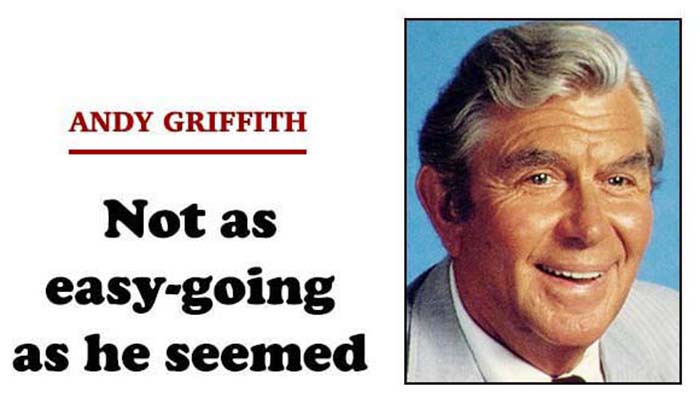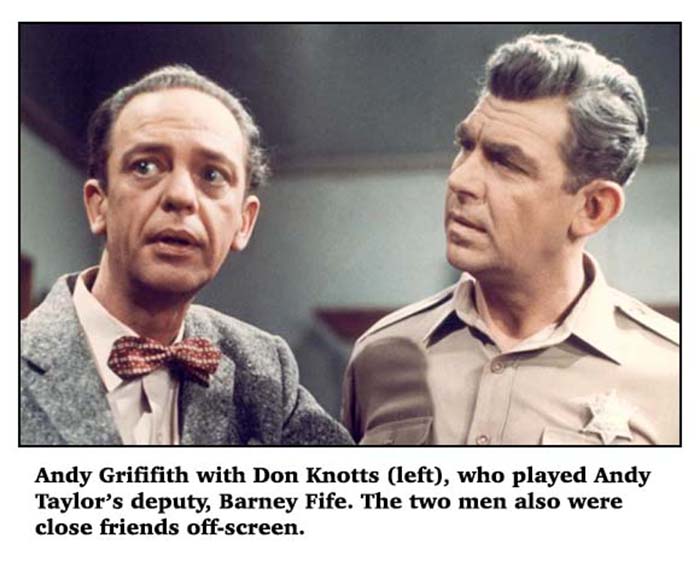| HOME |
 |
 |
| For some reason, you won’t find it among his credits on the usually complete and reliable Internet Movie Database website (imdb.com), but on February 26, 1967, Andy Griffith was host for a 60-minute CBS-TV special, “Andy Griffith’s Uptown-Downtown Show.” It was the top-rated show for the week. Several days before the special aired, Griffith visited a few cities to publicize the show. It was during his Cleveland stop that he was able to see a copy of the finished tape of his special. I was among a small group of newspaper writers who sat in a conference room at WJW-TV to watch the special with Griffith and his manager, Richard Linke, who was the executive producer of the show, and with some officials of the local CBS affiliate. Everyone in the room enjoyed the show — except Griffith, who couldn’t shake off his annoyance with guest star Tennessee Ernie Ford. “You could tell that he was reading the cue cards,” Griffith complained. “It was so obvious that it was distracting.” The rest of us either didn’t notice what Ford was doing, or weren’t bothered by it. We then went out to dinner, but any hopes for an interesting conversation with Griffith were spoiled by his reaction to Ford’s performance. The former school teacher who grew up in Mount Airy, North Carolina, had given his guest star a failing grade. He brightened only when Linke mentioned a lively and personable young blonde who had been one of the dancers on the show. “Yeah, she was something, wasn’t she?” said Griffith, finally smiling. That blonde turned out to be Goldie Hawn, who seven months later put away her dancing shoes and became an actress in the situation comedy, “Good Morning, World.” The show lasted only one season, but Ms. Hawn was back on television again the next fall as a regular in “Laugh-In,” which made her a star. Griffith, meanwhile, continued his success in “The Andy Griffith Show.” The program later became “Mayberry, RFD,” and Griffith’s character, small-town sheriff Andy Taylor, left, replaced by Ken Berry, who played Sam Jones. A few of the Mayberry residents who’d been around while Taylor was sheriff remained for awhile on the re-titled show. Griffith’s next series had him playing the title character in “Headmaster,” but the show ran only 14 episodes in 1970. A year later he had even less luck with “The New Andy Griffith Show,” playing a small-town mayor. That series ran only 10 weeks. For the next several years Griffith appeared as a guest on a few weekly series, including “Mod Squad,” and “Hawaii Five-O,” and starred in a few TV movies and one excellent theatrical release, “Hearts of the West” (1975). Two of his television movies — “The Girl in the Empty Grave” and “Deadly Game” (both 1977) — had him playing small-town police chief Abel Marsh, the character created five years earlier by James Garner in “They Only Kill Their Masters.” Those two films are often confused — at least in my mind — with “Winter Kill,” which he made in 1974, and with two he made in 1975 under the umbrella of “Adams of Eagle Lake,” a series idea that never panned out. To me, all five of these similar films could have been part of a series that would have been more entertaining than the enormously successful “Murder, She Wrote,” which came along in 1984. Griffith kept busy with work in the six-part series, “Washington: Behind Closed Doors”; the fine mini-series “Centennial”; “Salvage 1,” which ran 19 weeks in 1979, and a supporting role in the three-part television version of “From Here to Eternity,” which actually improved upon the 1953 classic in several ways Oscar-winning. (It may have been Natalie Wood’s finest performance; she was better suited than Deborah Kerr for the role of Karen Holmes.) Griffith went through the first half of the 1980s in a variety of roles, including an old one when he starred in “Return to Mayberry” in 1986. That fall, however, he took on what he later said was his favorite role — that of folksy lawyer Ben Matlock, a fellow who must have had the world’s largest collection of white suits. “Matlock” ran from 1986 to 1995. Before that, however, he was sidelined for several months by Guillain-Barre Syndrome. After “Matlock,” he took on only a few roles, and in 2000 had quadruple bypass surgery. He has a few credits after that, but they were small parts. His best-known might well have been his appearance in a Brad Paisley music video of “Waiting on a Woman.” Griffith returned to North Carolina, and died in Manteo, near the Outer Banks, on July 3, 2012, at the age of 86. He was married three times — to Barbara Griffith from 1949-72; Solica Casuto from 1975-81, and Cindi Knight, from 1983 until his death. He and his first wife adopted two children, Dixie Griffith and Andy Griffith Jr., who died in 1996. A music major at the University of North Carolina, Griffith entered show business telling humorous stories, most famous of which was “What It Was Was Football.” He became a star on Broadway in “No Time for Sergeants,” as Private Will Stockdale, a part he recreated in the 1958 movie version. However, he played an entirely different role in his 1957 film debut — as Larry “Lonesome” Rhodes, a drifter who becomes a small-town radio star, then moves on to nationwide television, where his ego inflates to the bursting point, finally revealing him to be a thoroughly contemptible — and contemptuous — human being. Few actors ever made a stronger impact in their first movie. |
 |
| HOME • STARSTRUCK • CONTACT |